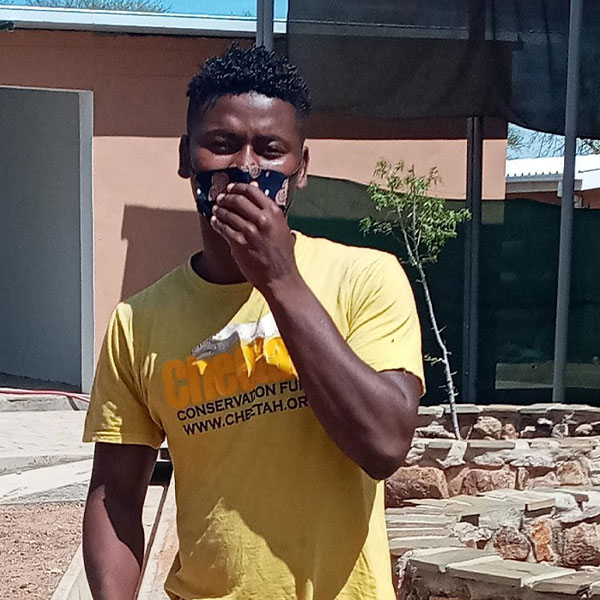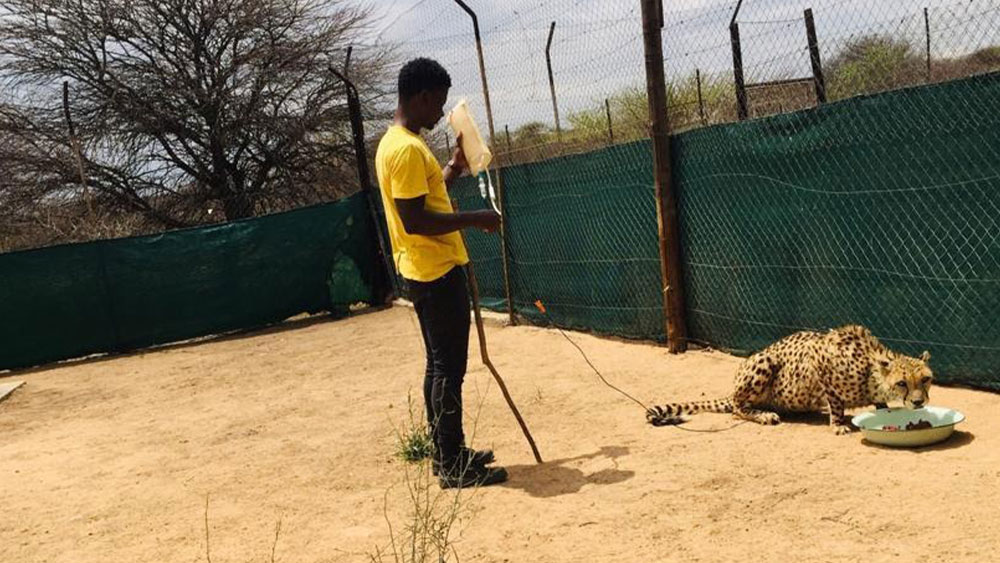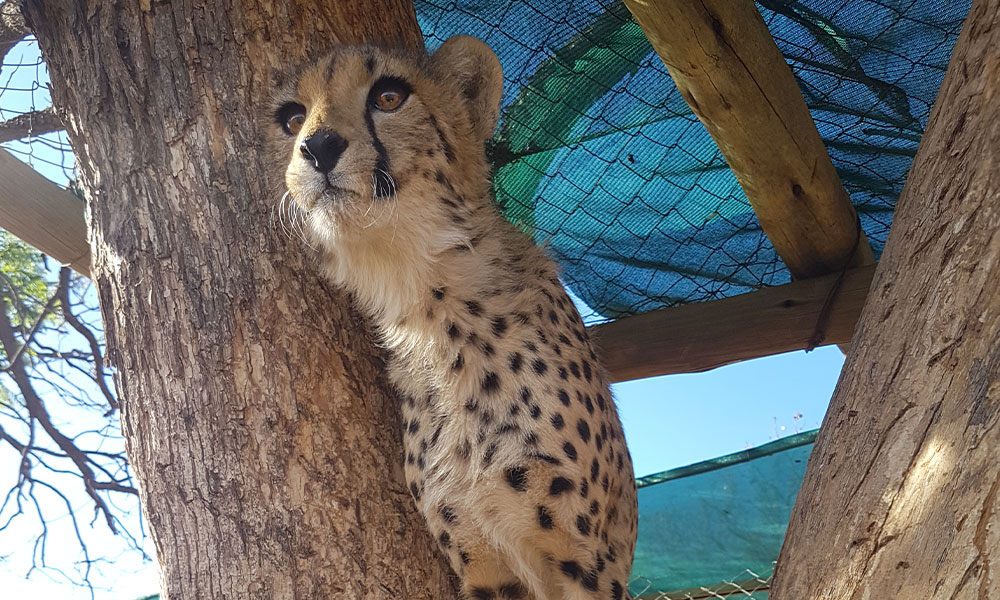Cheetah Husbandry Experience
-

- by Justin Moya January 25, 2021

I remember when I was a kid, I enjoyed watching films about wildlife in their natural habitats and my passion for wildlife became stronger as I grew up. After I was done with secondary school, it was a dream come true because it was always what I wanted to do, and I was able to study and learn about wildlife in their natural habitat.
In 2018, I was an intern at Cheetah Conservation Fund for six weeks. During my internship I helped with animal care tasks such as dog feeding and dog walking, goat checks and cheetah husbandry. I also assisted the ecology department with projects such as camera trapping and game counts. I was also involved with the scat dog detection program, where dogs are trained to find cheetah scat in the field. My time at CCF helped to solidify my passion for wildlife conservation, and I was excited to continue to expand on the knowledge and skills I had gained.
I came back to the CCF in July 2020 as a cheetah husbandry intern. I have been at the Centre for six months now, and time has flown by because there is just so much to learn here. I am working closely with the cheetah keepers learning how to care for the 40 cheetahs we currently have at the Centre.

Daily care of captive cheetahs involves feeding and preparing meat. Meat is prepared by checking for any small bones that can lead to choking and removing any excess fat, which is unhealthy for them to eat.
We also exercise our cheetahs, either on a long lure course or using a vehicle that they chase alongside the fence. Sometimes we will need to bring a cheetah into the clinic for a work-up. While under anesthesia, we can collect samples such as blood, semen and hair are taken for storage, study or laboratory test of both releasable and non-releasable cheetahs. Cheetah husbandry work is interesting and exciting, because every day is a little bit different.
Cheetahs that come to us above the age of six months old are considered “releasable”, because they have spent time with their mothers in the wild learning how to hunt and are very fearful and nervous around people. These cheetahs are kept far from the Centre away from people.
These cheetahs were brought to CCF because of human-wildlife conflict on farms in Namibia. Sometimes we get calls from farmers directly about a cheetah that is caught on their farm. We also work closely with the Ministry of Environment, Forestry and Tourism (MEFT) who call us about a problem or captured cheetah.
Once the cheetah arrives at the Centre after a day or two, a workup will be done in our veterinary clinic to check the health of the cheetah. Weight is recorded and samples such as blood, semen and hair are taken for storage, study or laboratory test blood. The cheetah is then tagged and collared before it can be released into the wild.
The non-releasable cheetahs who arrived younger than six months old are kept around the Centre for both educational purpose and for visitors who travel from different parts of the world to be able to see a cheetah close. These cheetahs are non-releasable because they were brought to CCF as young orphans below six months.
However, because they lose their mothers at a very young age they do not have enough time with their mother to learn how to hunt which is the skill they can only learn from their mothers. Cheetahs are naturally very shy of people, but when they are raised from a young age by the CCF staff, they also lose their natural fear of people, and it would be dangerous to release them as they could become a problem animal hanging around on a farm. Unfortunately, they must spend the rest of their lives in captivity at CCF. We try and provide them with the most natural life we can, and they are very well taken care of for their entire life while living here.
When I arrived in early July, I jumped straight into the cheetah husbandry role, and had my first medical case on a cheetah. A cheetah called Smartman (N’Dunge – seen in the photo at the top of this blog) on medication because he was suffering from gastritis and was having problems with digesting his food. He was also having trouble walking, but we didn’t know why. This case taught me a lot about diagnosing problems, and possible solutions to fix them. For the digestion, we started him on mincemeat rather than a large bone. The mince is much easier to digest, and he started to gain weight because of the change in diet.
For the unsteady walking, because we didn’t know what was causing it, we started him on a few different medications, to see what changes there were. We found that a combination of pain medication had the most effect, and it seemed to help him to feel better. I learned about how different medications help different systems. For instance, we use a medication called Peploc for stomach acid, Creon for the pancreas, and essential for the liver.
We continued to monitor him closely and worked the veterinarians to figure out the best combination and treatment option for Smart man. We had to be careful and note small changes in his behavior or his walking to know which drugs were working, and which were not. After months of careful observation and treatment, he is doing much better, and continues to gain weight and become healthy and strong again.


One of the fun parts of being a cheetah keeper is getting to work with young cubs when they arrive. We currently have Hans, who will be turning one year old in January. We also have Siyaya and Kabaka who are six months old, were brought to us three months ago after losing their mother in a veld fire. They were very dehydrated when they arrived, but after treatment of fluids and vitamins, they are doing well. Unfortunately, because they came to us so young, they will have to live at CCF their entire life, but we will look forward to them growing into strong, healthy adults.
I have learned a lot being here for six months so far, but I am looking forward to continuing learning more and more about the behavior of cheetahs in captivity and continuing to expand on my cheetah keeper skills and continue to build relationships with the cheetahs living at CCF.
Related Reading
-
December 3, 2023
Paws, Prints and DNA: Chronicles of a Genetics Intern -
June 15, 2023
Internship in the Ecology Department -
June 10, 2023
An Internship with Naughty Goats and Chocolates




